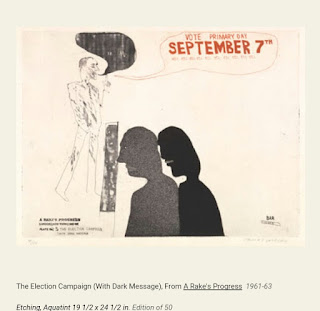David Hockney was born in England in 1973. He ia a well-known photographer, painter, draughtsman, print maker and stage designer.
"The Rakes Progress" is a series of etchings Hockney created, based on the work of English Artist, William Hogarth. In 1733 Hogarth produced a series of 8 paintings about the rise and fall of Tom Rakewell, each painting tells a different stage of what happened. In Hockney's version, there are 16 etchings. He also felt that inspired by Hogarth's work, in 1975, he began working with director John Cox to create production of Igor Starvinsky's opera based on Hogarth's, the rake progress.
William Hogarth's, "the Rakes story"is based on the fictional character, Tom Rakewell, who inherited a fortune from his late father but loses everything. The series of paintings were finished in 1733, they followed the popular, " A Harlots progress " which was about a woman moving from the countryside and becoming a prostitute. Unfortunately, the series was destroyed in a fire in 1755.
Hogarths, the Rakes Progress starts with a painting names, "The Heir" is of Tom being informed that he has inherited his miserly fathers fortune. He is attempting to pay off servant girl, Sarah Young who has on her hand, a gold ring, which was from an earlier, now retracted marriage proposal. There is also a lawyer stealing gold coins, an upholsterer who finds some hidden money and servants hunting for money and goods in the fireplace and behind wall hangings.
The second painting, "The levee" is of Tom holding a morning reception for other wealthy gentlemen. There are also professionals including a gardener and a tailor offering their services.
"The Orgy" is the third painting in the series. Tom is enjoying a drink with some prostitutes at the Rose Tavern in Covent Garden. The scene is set at 3am and the woman at the front is undressing in preparation for her naked poses.
"The Arrest" is the next painting in the series which shows Tom narrowly avoiding arrest on the way to the Queens birthday reception at St James Palace. it is Sarah Young who pays his bail money for his freedom with the little earnings she has.
"The Marriage" tells of Toms decision to marry an elderly woman for her fortune. The idea of living a life without luxury was not an option. The woman has one eye and does not hold Toms interest.
"The gaming House" shows Tom angry at fate due to his incredible of his second fortune - He gambled everything and lost.
The seventh in the series is, "The prison" is a picture of Tom is a prisoner of the Fleet, Londons infamous debtors prisons. The prisoners are hopeless, some are desperate to find an escape route, and some are presenting the first signs of insanity.
The 8th and final image in the series is named, "The madhouse -the end of the line". At this point, Tom is now in Bethlem hospital-often called Bedlam- after his descent into madness. There are people with various delusions, One man who is unclothed thinks he is a king. In the background, there are women who have came to view the mentally ill. As Bedlam was open to the public, this was a fun day out for the wealthy to look down on the less fortunate.
The heir
The levee
The Orgy
The Arrest
The Marriage
The Gaming House
The prison
The madhouse - the end of the line
Hockney used these paintings for inspiration but told his story over 16 prints. These prints have been designed around the modern day. Although it is clear Hockney has added his own personal style, I feel that Hogarth's work is more interesting. I find Hogarth's work has more depth and I can almost get a feel for what each situation would have been like. I find it difficult to relate to Hockney's version of "The Rakes Progress".

























No comments:
Post a Comment